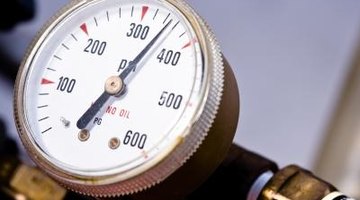How to Add a Second Tank to an Air Compressor
One of the keys to using air compressors to drive tools is maintaining steady pressure. While there is a limit to the capacity of smaller compressors, adding air volume with an auxiliary air tank will keep pressure at a steadier level. Air tanks are fairly simple. You will need a passive tank that allows pressurized air in from the compressor and out to your tools. This requires both an inlet opening and an outlet, as opposed to single-outlet tanks, such as propane and helium tanks.

-
Wrap Teflon tape around the threads of a male quick connect and thread it into one of the openings in your air tank. Tighten the fitting in the threads with a wrench until it is snug. This will serve as the inlet for your tank. Repeat the process with a female quick connect in the remaining threaded opening in the tank. This will serve as the outlet.
-
Attach a short, flexible air hose to your compressor. Pull back the ring of the female quick connect on the compressor's outlet and fit the male connector on the end of the air hose into it, releasing the ring to fasten it in place. Pull the ring back on the female end of the air hose and fit it over the male connector on the air tank. Release the ring to fasten it in place.
-
Pull back on the ring of the female outlet connector on your air tank and insert the male end of a second air hose. Attach the female end of the air hose to the connector on an air tool, such as a nail gun or sander.
-
Start the compressor and allow the pressure to build up until it stops. Spray soapy water around the fittings on the air tank and check for bubbles. Tighten any fittings that produce bubbles, until the bubbling stops. Use the air tool as you would with just the compressor; the added capacity will increase usable pressure and give you smoother tool operation.
References
- "Air Tools"; Rick Peters; 2000
- AboutAirCompressors.com: Troubleshooting Your Compressor
Writer Bio
Mark Morris started writing professionally in 1995. He has published a novel and stage plays with SEEDS studio. Morris specializes in many topics and has 15 years of professional carpentry experience. He is a voice, acting and film teacher. He also teaches stage craft and lectures on playwriting for Oklahoma Christian University.
Photo Credits
- Jupiterimages/Photos.com/Getty Images
More Articles



